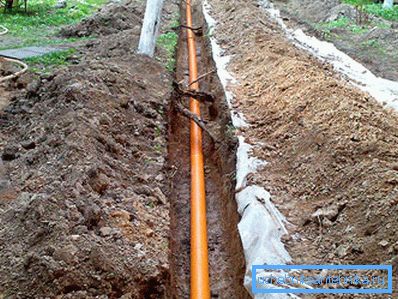Modern ceramic pipes as an option for home plumbing
One of the most environmentally friendly materials for construction are ceramic pipes. The method of production of such products by roasting clay caused their primary use in places where they would have to work with hot and aggressive media. Depending on the purpose, various additives are added to ceramics for the production of pipes, which significantly increase the strength of the products, read on this and others.

Manufacture of ceramic pipes
So, in order.
To begin with, we will study the technology of producing pipes from ceramics so that you can more clearly describe the process in stages:
- For processing and preparation of raw materials use the same equipment as in the manufacture of bricks. This process includes:
- Grinding clay - removing lumps.
- The introduction of special additives that increase the strength of products.
- Procurement of the mass for the formation of products.

- Tunnel kilns.
- Finally, the ceramic is glazed from the inner and outer sides by dipping into a special pool..
Note! Glazed ceramic pipes are not afraid of any aggressive environment, which greatly increases their service life.
Spheres of application
Due to its excellent quality and performance characteristics, ceramics are used in various areas of production and in the household sector.
According to the intended purpose, these products are divided into:

- Ceramic pipes for sewage. Distinctive features:
- High wear resistance.
- Non-corrosive.
- They are not sensitive to temperature changes.
- They are not afraid of the aggressive effects of sewage fecal or chemically saturated industrial waste.
- Practical and convenient styling.

Tip! Ceramic chimney - the best choice when building your own fireplaces and stoves. This may be a ceramic pipe for a bath, designed for firewood (traditional Russian) or other solid fuel.
Without exception, all products made of ceramics, regardless of the scope of application, differ from their counterparts as follows:
- Relatively low price of products.
- The durability of the structures created from them (you do not need repairs in the next 5-10 years).
- Ecological safety for human health and the environment - the background is not disturbed.
- Thermo-chemical resistance to various influences.
Attention! The only drawback of a ceramic pipe is its vulnerability to mechanical impact, for example, a fallen hammer can damage a sewer system element. It is unstable before strong shocks, the poem installation work should be carried out carefully.

Technological nuances in work with a ceramic pipe
As already mentioned above, the ceramic pipe does not like neglect. Therefore, the first rule of mounting a product of any functional orientation is a thorough inspection and, if necessary, rejection of products with manufacturing defects or obtained during transportation.

The section below is a ceramic pipe work instruction manual that will help you do the work yourself.
Sewage installation features
Ceramic pipe for discharge of sewage is free-flow, therefore it must be laid with maintaining a certain design slope, to ensure a free flow. However, it is important not to make this slope too steep, it contributes to the accumulation and occurrence of precipitation on the inner walls of products. Also, an insufficient angle makes it difficult to move liquids.
In addition to the absence of cracks and chips, ceramic sewer pipes should:
- To be straight across the entire length, although small millimeter deviations are permissible.
- Do not have deviations of the main geometrical parameters — roundness of the cross-section, ovality of the socket, etc. Or those should be within the specified tolerances.
A few simple installation rules to ensure the quality of the laying of the pipeline of ceramics:
Note! The depth of the trench depends on the groundwater level, this indicator is very important because it affects the efficiency of the drainage system.

- The pipe is laid from the manhole.
- Rattles on the product should be directed against the flow of waste.
- The joints at the junction of the pipeline sections are hermetically sealed with pitch or hemp-impregnated with bitumen. The strand fits into two or more coils with a soft, unstressed seal.
Note! The rest of the space in the socket is filled with preheated mastic with the help of a metal holder, greased with clay and closely mounted on the pipe. Mastic is poured into the holder. After complete sealing of the sealant, the clip is removed.
Ceramic pipe cutting
If you need to cut the pipes, you can use:
- The usual angle grinder (grinder) with a diamond disc or a cutting head on the stone. After cutting, the ends should be carefully processed with emery paper.
- Special pipe cutters. To work with a ceramic pipe, use a chain tool that can cut a product with a diameter of 50 to 150 mm, and some models with an extended chain even up to 300 mm. The chain is fixed in place of the cut on the pipe and rigidly tightened with a ratchet mechanism. In this case, the cutting rollers “bite” into the body of the pipe and at the moment of maximum stress it bursts.

Conclusion
The article is a recommendation, we do not claim that ceramic pipes are the best option for laying a pipeline in a country house. But everyone should pay attention to these products, as they are very unique, you will definitely find some area where ceramics will be the most practical.
In the presented video in this article you will find additional information on this topic.